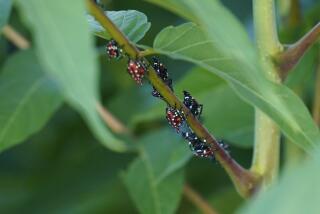Scientists Dispute Report on New Whitefly
- Share via
Three California scientists are challenging findings of a UC Riverside research team’s Jan. 1 report that the whitefly that has been devouring Southwest crops is a distinct species, rather than a strain of the common whitefly.
James Duffus of the U.S. Department of Agriculture’s research station in Salinas; Bruce C. Campbell, an entomologist at the USDA’s western regional research center in Albany, Calif., and Paul Baumann, a microbiologist at UC Davis, say their findings show that the Strain B whitefly is indeed a variety of the well-known sweet potato whitefly and not a separate species.
In the Jan. 1 issue of the journal Science, a UC Riverside research team led by Thomas Perring reported it had confirmed that the new, voracious whitefly is a separate species and named it the silverleaf whitefly for the silvery look of the damage it causes to squash leaves. The new whitefly has been seen in the United States for about five years, and in the past two years has done extensive damage throughout California’s Imperial Valley. It is estimated that the pest has destroyed $1.5 billion worth of crops.
The Perring report is expected to be a major topic of debate at a meeting beginning today in Tempe, Ariz., where more than 120 whitefly researchers and experts are expected to participate in the first review of a national plan, adopted one year ago, to control the new whitefly.
Other scientists have also expressed misgivings about the Perring report. Duffus, Campbell and Baumann are expected to air their challenge in a scientific publication.
More to Read
Sign up for Essential California
The most important California stories and recommendations in your inbox every morning.
You may occasionally receive promotional content from the Los Angeles Times.













